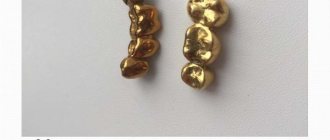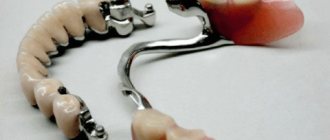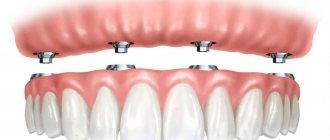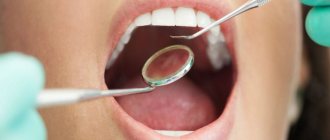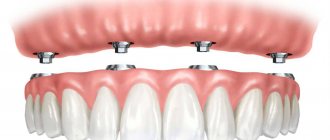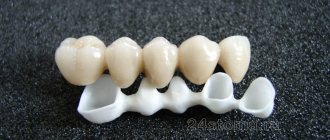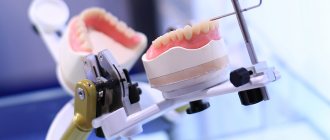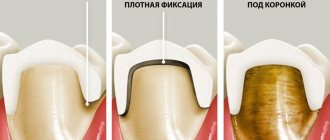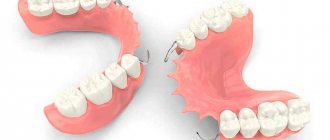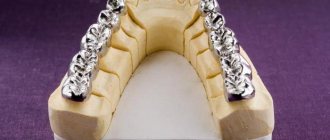The metal-plastic prosthesis does not cause any harm to the installed implants; on the contrary, due to the metal base, it stabilizes their position and also transfers the chewing load to the bone, activating its faster regeneration.
Metal-plastic dentures use acrylic and new generation plastics with the addition of diamond chips. This makes the materials more durable, resistant to mechanical stress and gives them shine, which allows for a better appearance and naturalness.
Advantages and disadvantages of metal-plastic bridges
If a patient is missing one or two or even three or four teeth in a row, then, in the absence of contraindications, a bridge prosthesis can be installed. The capabilities of this orthodontic design are well known to all dentists in the world and their patients, because thanks to the “bridges,” it is possible to restore both the chewing function and the “smile zone.” The network of dental clinics "Doctor Martin" provides dental prosthetics services and offers everyone who is not yet ready to install an expensive and durable bridge to install a temporary structure - a metal-plastic bridge.
Indications for installation of metal-plastic crowns
Crowns can be installed in a number of cases:
- If one to three teeth are missing in a row, a dental bridge can be installed. The condition is the absence of an end defect, that is, the presence of the patient’s own teeth on both sides of the defect.
- Significant destruction of the crown part of the tooth while maintaining its own strong root. The destruction should not go below the gum level. Otherwise, it will not be possible to achieve a perfect fit and the tooth will have to be removed.
- Darkening of teeth, cracks and chips, and other defects that a crown can eliminate.
- Pathological abrasion of enamel.
- Increased sensitivity of teeth.
- Slight curvature of the dentition when the patient is unwilling to correct the situation in other ways (braces, mouth guards).
Peculiarities
The metal-plastic bridge is based on a solid-cast metal structure covered with a composite plastic lining. This is a fairly durable product that exactly repeats the shape of the lost dental units, but it cannot be said that they are indistinguishable from real teeth, because over time these differences become more pronounced. So why install such a design? And then that it can be difficult to do without it and here’s why.
Different goals and hopes are assigned to bridges, depending on the clinical picture. Installing a long-term bridge requires certain financial costs from the patient, and you need to get used to the prosthesis itself, because it is still a foreign body. Metal-plastic bridge prostheses most often take on the role of a temporary orthodontic structure, since their service life does not exceed three years. It is appropriate to install them on implants, and real teeth are rarely ground for these purposes, due to the fragility of the prosthesis.
If the installation of implants is not required due to the presence of supporting teeth, then they are subjected to grinding. Some patients plan to use the bridge constantly until it becomes unusable, and along with it the ground supporting teeth. Dentists at the Doctor Martin clinic strongly recommend against this idea, since such orthodontic products are intended for temporary use. They are indispensable in cases where there is an urgent need to eliminate defects in the dentition, and the metal-ceramic or all-ceramic structure is not yet ready.
Prosthesis service life
Metal-plastic dentures with an acrylic base are used at the first stage of prosthetics during implantation with immediate loading. The minimum period of wearing them is six months to a year, during which time the implants take root. However, such a prosthesis will last about 3-5 years. Therefore, it will be possible to replace it with a structure made of more practical and durable materials - fiberglass, ceramic composite, zirconium or metal-plastic - after this period has expired, that is, after the loss of aesthetics or breakage of the prosthesis.
More examples
Read detailed instructions for caring for the oral cavity and dentures after dental implantation >>>
Comparison of metal-plastic and ceramic composite
At the Smile-at-Once clinic, when performing one-stage dental implantation with immediate loading (basal complex and All-on-6), two types of prostheses are used, which are installed 1-3 days after implantation. This is directly metal-plastic, as well as a modern photopolymer ceramic-composite prosthesis. We presented a comparison of the two types of structures in the table:
| Photopolymer ceramic composite | Metal-plastic | |
| Original aesthetics | high | relatively high |
| Preservation of appearance during operation | is maintained at a high level - the material does not absorb dyes and does not darken if hygiene is observed | during the year – high, then – decreases: the color of the crowns changes, plaque accumulates |
| Possibility of repair | possible directly in the oral cavity | possible directly in the oral cavity |
| The need for re-prosthetics (stage II) | Not required | required at least six months to a year, or after the prosthesis breaks |
| Clinic guarantee | 5 years | 1 year |
| Life time | from 10 years or more | no more than 5 years |
| Cost of basal implantation together with prosthesis for one jaw | from 400,000 rubles | from 250,000 rubles |
Flaws
- Short service life (up to three years).
- The resin may not match the tone of real teeth.
- Coloring pigments, aggressive environment in the mouth and other factors negatively affect plastic lining.
- To prevent the metal from showing through the plastic, a thick layer of veneer has to be applied to the crown part, and the abutment tooth is ground down more intensively, which is clearly not good for it.
- Plastic and metal do not make good contact with each other, and the bridge may break under strong mechanical stress.
- If the structure is used as a permanent structure, the risk of periodontal disease and caries increases significantly.
Types of metal-plastic prostheses
For the convenience of patients, two types of metal-plastic prostheses are used:
- Individual - created by analogy with other orthopedic products. The doctor takes impressions of the teeth, sends the data to dental technicians, and they first make a metal base and then cover it with a plastic veneer to recreate the shape and color of natural enamel. With such a bridge you can walk without problems for up to 3 years.
- Universal – such products are in the orthopedist’s arsenal, and you can literally immediately get it for an urgent solution to the problem. For example, after tooth extraction. In some cases, such a prosthesis can be worn even on unground teeth.
Manufacturing stages
Metal-plastic bridges can be installed both on the day of turning the supporting teeth, and after some time. Patients of the Doctor Martin clinic have two types of designs available:
- Cast, manufactured in laboratory conditions. The metal frame is made from an individual plaster cast, which is taken several times for maximum accuracy. Moreover, cobalt-chrome alloys and even precious metals can be used as a basis. At the request of the patient, a layer of composite plastic can be applied only to the front part of the prosthesis.
- Stamped. These are standard products, manufactured in advance and constantly available in the doctor’s office. They are made very simply: semi-soft plastic is applied to a metal base, which hardens under the influence of light emitted by a special lamp.
If the patient has lost only one dental unit, then he should consider the option of installing an adhesive (adhesive) bridge, where a fiberglass tape is used as a support, fixed with a special adhesive composition in the protrusions on the supporting teeth. Such orthodontic products also have the status of temporary and are not designed for long-term use, as well as bridge-like composite prostheses on inlays.
Content
- Features of crowns
- Indications for installation
- Advantages and disadvantages
The loss or destruction of one or more teeth is not a serious problem today. There are a number of different options for eliminating this problem using modern prosthetic techniques. Installing crowns is the most common option, allowing you to solve both aesthetic and functional problems in one step. Such fixed dentures can be made from a variety of materials, one of which is metal-plastic.
Dental bridge: what material is best to choose from?
If we are talking about prosthetics of the front teeth, then according to statistics, most patients are dissatisfied with the bridges made for them.
As we said above, it is very difficult to make artificial crowns similar in color and transparency to neighboring teeth and, of course, good aesthetics today can be achieved mainly only by using metal-free ceramics - 1) Emax glass ceramics, 2) zirconium dioxide. But we also don’t forget about metal-ceramics, although there is one problem with it when prosthetizing the front teeth. Modern metal-ceramics in some cases can look almost as aesthetically pleasing as metal-free ceramics, but for this it is necessary - 1) to use expensive ceramic masses, 2) metal-ceramics must be made with the so-called “shoulder mass”. But this raises the cost of a metal-ceramic bridge to 20,000 rubles (for 1 Unit/crown). And this is practically the cost of 1 unit of pressed ceramics “Emax”.
Below we will talk in detail about which bridge is optimal for the front teeth (in terms of materials and budget). But with prosthetics with bridges in the area of chewing teeth, the situation is much easier, because here functionality is more important than aesthetics. And in this case, we have a number of optimal solutions, including more affordable ones, although the gold standard for chewing teeth is now expensive bridges made of monolithic zirconium dioxide.
Below we compare the following types of bridges -
- bridges made of metal-free ceramics (zirconium dioxide, E.max),
- metal-ceramic dental bridges,
- solid bridge made of cobalt-chrome alloy,
- adhesive bridge prosthesis.
Care
A metal-plastic bridge requires no less care than natural teeth.
The structures should be cleaned with specialized abrasives and an ordinary toothbrush. The technique for performing bridge treatment is no different from traditional oral care.
It is important to remember that plastic products require more careful cleaning, since scratches and chips easily form on their surface. This fact can reduce the operating time of bridges.
Also, the installation of any prosthesis involves the refusal of dental cleaning of teeth, in particular, this rule applies to cleaning using water under high pressure.
Patient reviews
The decision to save on a tooth that is “not visible” resulted in having to pay twice. It chipped quickly and lost its nice color, since I am a big coffee lover.
Marina
I don’t complain about metal-plastic and have never regretted that I didn’t covet something more expensive. It’s been standing for two years now and at least he doesn’t care. Looks good, the results of the examination at the dentist are encouraging. And this despite the fact that it cost much less and the finished tooth was made in less than a week.
Vladimir
Resin bridges were a bad idea.
Maybe it’s normal with one or two teeth, but I had several replaced at once, now I have to go to the doctor again. Everything started to change and my teeth felt somewhat unpleasant to the touch. Maksim
Metal-ceramic crowns pros and cons
Advantages of metal ceramics:
- Experienced specialists will be able to make a crown that completely imitates the natural color of the patient’s natural teeth. It will be difficult to notice the difference between artificial teeth made of metal-ceramics and natural ones;
- The combination of materials makes it possible to achieve a strength comparable to, and sometimes exceeding, the strength of natural teeth;
- The service life is impressive; if hygiene requirements are met, teeth made of metal-ceramics can last more than 15 years;
- Resistant to plaque formation and staining, retains its original appearance.
Imperfections of metal ceramics:
- The main disadvantage is the necessary grinding of a natural tooth in order to install a metal-ceramic crown; the tissue of the natural tooth is removed to the state of a stump;
- There is a possibility of allergic reactions to the metal alloy component used;
- On a poorly made prosthesis, a section of the frame may become exposed over time.
Crowns on metal-ceramic teeth do not require special care; it is enough to carry out daily oral hygiene.
In the presented photo before and after prosthetics, you can see how natural teeth made of metal-ceramics look:
